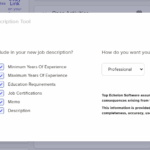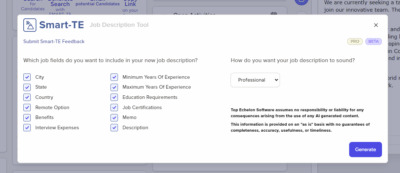Workforce planning is the process of anticipating and meeting future business needs by identifying the required workforce size, skills, and competencies. It is a critical process for any organization that wants to achieve its goals and stay competitive.
In this blog post from Top Echelon Recruiting Software, we will delve into the various aspects of workforce planning, its importance, and strategies for anticipating and meeting future business needs.
What is Workforce Planning?
Definition and Overview
Workforce planning is the systematic process by which an organization identifies its current and future human resource needs to achieve its goals. This involves a thorough analysis of the workforce, determining the skills and competencies required, and developing strategies to address any gaps. Workforce planning is not a one-time activity but an ongoing process that aligns with the strategic objectives of the organization.
Strategic Alignment
Workforce planning ensures that an organization’s human resource strategies are aligned with its overall business goals. This strategic alignment is crucial for the organization’s long-term success. It involves understanding the organization’s mission, vision, and strategic priorities and ensuring that the workforce can support these objectives. By aligning workforce planning with business strategy, organizations can proactively address future challenges and capitalize on opportunities.
Steps in Workforce Planning
1. Analyzing the Current Workforce
The first step in workforce planning is to analyze the current workforce. This involves collecting data on workforce demographics, skills, and capabilities. Organizations need to understand the age distribution, gender diversity, educational background, experience levels, and other relevant characteristics of their employees. This analysis provides a baseline for understanding the strengths and weaknesses of the current workforce.
2. Forecasting Future Workforce Needs
The next step is to forecast future workforce needs. This involves predicting the demand for products and services, understanding industry trends, and assessing the potential impact of technological advancements, economic shifts, and regulatory changes. Accurate forecasting helps organizations prepare for future challenges and opportunities. It involves both quantitative and qualitative analysis to anticipate the number and types of employees needed.
3. Identifying Gaps or Shortages
Once future workforce needs are forecasted, organizations must identify any gaps or shortages in their current workforce. This involves comparing the current skills and capabilities of employees with the skills required to meet future business goals. Identifying these gaps helps organizations develop targeted strategies to address them, such as hiring new employees, developing current employees, or outsourcing certain functions.
4. Developing Workforce Plans
Based on the analysis and forecasting, organizations can then develop comprehensive workforce plans. These plans should outline the actions needed to ensure the organization has the right workforce to meet its future business needs. Workforce plans should include strategies for recruitment, training, development, and retention. They should also set clear timelines and milestones for achieving the objectives.
5. Implementing Workforce Plans
Effective implementation of workforce plans is crucial for success. This involves communicating the plan to all stakeholders, including employees, managers, and other key individuals. Organizations should provide the necessary resources and support to enable successful implementation. This includes offering training and development opportunities, providing incentives for high performance, and creating a supportive work environment that fosters engagement and commitment.
6. Monitoring and Evaluating Progress
Monitoring and evaluating progress is essential to ensure the workforce plan achieves its objectives. Organizations should establish key performance indicators (KPIs) to measure the success of the plan. Regular tracking of these KPIs helps identify any deviations from the plan and allows for prompt corrective actions. Continuous evaluation ensures the workforce plan remains aligned with the organization’s goals and objectives.
Importance of Workforce Planning
Ensuring the Right Talent
One of the primary benefits of workforce planning is ensuring that the organization has the right talent to meet its future business needs. By forecasting future demands and identifying gaps, organizations can proactively recruit, train, and develop employees with the necessary skills and competencies. This proactive approach helps prevent talent shortages and ensures that the organization can operate effectively.
Reducing Recruitment Costs
Effective workforce planning helps reduce costs associated with recruitment, training, and development. By anticipating future needs and developing internal talent, organizations can minimize the expenses related to hiring new employees. This not only saves money but also ensures a smoother transition as existing employees are already familiar with the organization’s culture and processes. Additionally, by reducing turnover rates, organizations can save on the costs associated with constantly replacing employees.
Increasing Employee Engagement and Retention
Workforce planning contributes to higher employee engagement and retention by providing opportunities for growth and development. When employees see a clear career path and receive the necessary support to advance their skills, they are more likely to remain committed to the organization. This reduces turnover rates and enhances overall organizational stability. Engaged employees are also more productive, motivated, and aligned with the organization’s goals.
Enhancing Organizational Agility
In a rapidly changing business environment, organizational agility is crucial. Workforce planning enables organizations to respond quickly to changes in the external environment. By anticipating future needs and having a flexible workforce, organizations can adapt to new market conditions, technological advancements, and regulatory changes more effectively. This agility allows organizations to stay competitive and seize new opportunities as they arise.
Improving Organizational Performance
Aligning the workforce with the organization’s goals and objectives leads to improved performance. When employees possess the right skills and are motivated to achieve business objectives, productivity and efficiency increase. Workforce planning ensures that the organization is well-prepared to meet its goals and maintain a competitive edge. Improved performance also enhances the organization’s reputation, customer satisfaction, and overall success.
Strategies for Anticipating and Meeting Future Business Needs
Conducting Regular Market Research
Regular market research is essential for identifying trends and opportunities in the industry. Organizations should stay updated on market dynamics, customer preferences, and competitor activities. By understanding these factors, organizations can make informed decisions about their workforce needs and adjust their strategies accordingly. Market research also helps identify potential disruptions and emerging technologies that may impact the workforce.
Developing a Talent Pipeline
Creating a talent pipeline involves identifying potential future employees and providing them with the necessary training and development. This ensures a steady supply of skilled individuals who can step into key roles as needed. Organizations should establish partnerships with educational institutions, offer internships and apprenticeships, and engage in proactive talent scouting. A strong talent pipeline reduces the time and cost associated with external recruitment.
Offering Flexible Work Arrangements
Flexible work arrangements, such as remote work, flexible hours, and job sharing, can help attract and retain top talent. These arrangements cater to the diverse needs of employees and enhance work-life balance. By offering flexibility, organizations can appeal to a broader pool of candidates and improve employee satisfaction. Flexible work arrangements also increase productivity and reduce absenteeism.
Fostering a Culture of Learning and Development
A culture of continuous learning and development is crucial for workforce planning. Organizations should encourage employees to take on new challenges, acquire new skills, and pursue professional development opportunities. This can be achieved through training programs, mentorship, online courses, and encouraging a growth mindset. A culture of learning fosters innovation, adaptability, and resilience within the workforce.
Building a Diverse Workforce
Diversity in the workforce brings a range of perspectives and ideas, enhancing creativity and innovation. Organizations should strive to build a diverse workforce that reflects the needs and perspectives of their customer base. This involves implementing inclusive hiring practices, promoting diversity and inclusion initiatives, and creating an environment where all employees feel valued and respected. A diverse workforce also improves decision-making and problem-solving abilities.
Leveraging Technology and Data Analytics
Technology and data analytics play a significant role in workforce planning. Organizations should leverage advanced tools and software to collect, analyze, and interpret workforce data. Data analytics helps identify trends, predict future needs, and optimize workforce strategies. Additionally, technology enables efficient communication, collaboration, and training, enhancing overall workforce management.
Succession Planning
Succession planning is a critical component of workforce planning. It involves identifying and developing internal candidates to fill key leadership and critical roles in the organization. Succession planning ensures business continuity and minimizes disruptions caused by unexpected departures or retirements. Organizations should establish clear succession plans, provide leadership development programs, and regularly assess potential successors.
Engaging Employees in Workforce Planning
Engaging employees in the workforce planning process is essential for its success. Employees have valuable insights and perspectives that can inform workforce strategies. Organizations should involve employees in discussions about future needs, skills development, and career progression. Engaging employees fosters a sense of ownership, commitment, and alignment with the organization’s goals.
Implementing Performance Management Systems
Performance management systems are crucial for monitoring and evaluating employee performance. These systems help organizations identify high performers, address performance issues, and align individual goals with organizational objectives. Effective performance management systems include regular feedback, performance appraisals, goal setting, and development plans. By managing performance effectively, organizations can optimize their workforce and achieve better results.
Establishing a Strong Employer Brand
A strong employer brand attracts top talent and enhances employee retention. Organizations should invest in building a positive reputation as an employer of choice. This involves promoting the organization’s values, culture, and benefits to potential candidates. A strong employer brand differentiates the organization from competitors and creates a compelling value proposition for current and future employees.
The Role of an Applicant Tracking System (ATS) in Workforce Planning
Introduction to ATS
An applicant tracking system (ATS) is a software application that automates and streamlines the recruitment process. It helps organizations manage the entire hiring process, from posting job openings to onboarding new employees. An ATS is a critical tool in workforce planning as it enhances efficiency, improves candidate experience, and provides valuable data for decision-making.
Enhancing Recruitment Efficiency
An ATS automates various aspects of the recruitment process, reducing the time and effort required to fill open positions. It allows recruiters to post job openings on multiple platforms simultaneously, track applications, and schedule interviews. Automation of these tasks frees up recruiters to focus on more strategic activities, such as engaging with top candidates and building relationships.
Improving Candidate Experience
A positive candidate experience is crucial for attracting and retaining top talent. An ATS provides a seamless and user-friendly application process, making it easy for candidates to apply for positions. Features such as automated acknowledgments, real-time status updates, and personalized communication enhance the candidate experience and strengthen the organization’s employer brand.
Data-Driven Decision Making
An ATS collects and analyzes a wealth of data related to the recruitment process. This data provides insights into various aspects of workforce planning, such as the effectiveness of different recruitment channels, time-to-fill metrics, and candidate demographics. Organizations can use this data to identify trends, optimize recruitment strategies, and make informed decisions about future workforce needs.
Enhancing Collaboration and Communication
Effective collaboration and communication are essential for successful workforce planning. An ATS facilitates collaboration among hiring managers, recruiters, and other stakeholders by providing a centralized platform for sharing information and feedback. It streamlines communication, reduces misunderstandings, and ensures that everyone involved in the hiring process is on the same page.
Ensuring Compliance and Reducing Bias
An ATS helps organizations ensure compliance with labor laws and regulations by automating documentation and record-keeping. It also reduces the risk of bias in the hiring process by standardizing evaluation criteria and providing objective data for decision-making. By promoting fairness and transparency, an ATS enhances the organization’s reputation and attracts a diverse pool of candidates.
Integrating with Other HR Systems
An ATS can integrate with other HR systems, such as Human Resource Information Systems (HRIS) and Learning Management Systems (LMS). This integration allows for seamless data flow between different systems, enhancing overall workforce management. For example, data from the ATS can inform training and development programs, succession planning, and performance management.
Supporting Remote and Hybrid Workforces
With the rise of remote and hybrid work models, an ATS is essential for managing a geographically dispersed workforce. It enables organizations to conduct virtual interviews, onboard remote employees, and maintain consistent communication regardless of location. This flexibility is crucial for attracting and retaining top talent in a competitive job market.
Enhancing Talent Pipelines
An ATS helps organizations build and maintain talent pipelines by tracking candidates who may be a good fit for future opportunities. It allows recruiters to nurture relationships with potential candidates through targeted communication and engagement strategies. By keeping a pool of qualified candidates readily available, organizations can respond quickly to changing workforce needs.
Workforce Planning in the Future
Workforce planning is a critical process for any organization that wants to achieve its goals and stay competitive. By anticipating and meeting future business needs, organizations can ensure they have the right talent in place to drive success. Effective workforce planning involves analyzing the current state of the workforce, forecasting future needs, identifying gaps, developing comprehensive plans, implementing strategies, and continuously monitoring progress.
Organizations that prioritize workforce planning benefit from reduced recruitment costs, increased employee engagement and retention, enhanced organizational agility, and improved overall performance. By employing strategies such as regular market research, developing a talent pipeline, offering flexible work arrangements, fostering a culture of learning and development, building a diverse workforce, leveraging technology and data analytics, engaging employees, implementing performance management systems, and establishing a strong employer brand, organizations can effectively anticipate and meet their future business needs.
An applicant tracking software plays a vital role in workforce planning by enhancing recruitment efficiency, improving candidate experience, providing data for decision-making, and supporting remote and hybrid workforces. By integrating an ATS into their workforce planning processes, organizations can streamline recruitment, ensure compliance, reduce bias, and build robust talent pipelines.
In today’s dynamic business environment, workforce planning is not just a necessity but a strategic imperative. Organizations that invest in comprehensive workforce planning and leverage tools like ATS are better positioned to navigate challenges, seize opportunities, and achieve long-term success. By adopting a proactive and strategic approach to workforce planning, organizations can ensure they have the right talent to thrive in an ever-changing world.








